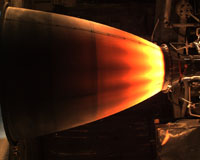 |
New Delhi, India (SPX) Apr 21, 2010 India will temporarily go back to using Russian-produced space equipment after its indigenous GSLV rocket failed, a spokesman for Indian Space Research Organization (ISRO) said on Friday. The Geosynchronous Satellite Launch Vehicle, GSLV D3, fell into the Bay of Bengal 304 seconds after liftoff as its cryogenic engine failed to perform. The rocket tumbled, lost altitude and finally splashed down in the sea. 'Five launches are scheduled for the 2010-2011 fiscal year [which began April 1], including two GSLV and three PSLV launches. The next two GSLV will be launched with Russian cryogenic engines," ISRO spokesman S. Satish said. India earlier bought seven Russian-made 12KRB oxygen-hydrogen booster sections, five of which have already been used for launches. India is seeking to become the sixth country to develop its own cryogenic booster sections, necessary for lifting heavy satellites to geostationary orbit. Until recently, only the United States, Russia, France, Japan and China had the technology. The head of the Indian Space Research Organization (ISRO), K. Radhakrishnan, said the next rocket launch with a domestically produced cryogenic engine will be held this year. ISRO recently announced that from now on it will orbit 10 satellites every fiscal year. The crashed GSLV, 50 meters long and weighing 416 tons, was meant to orbit G-Sat, a sophisticated 2.2-ton communications satellite. The cost of the failed launch is estimated at $75 million, including $40 million for the rocket's construction.
Source: RIA Novosti
Share This Article With Planet Earth
Related Links - Rocket Science News at Space-Travel.Com
 Testing Future Engine Technology Is A Work Of Art
Testing Future Engine Technology Is A Work Of ArtHuntsville AL (SPX) Apr 20, 2010 An engine nozzle turns a dramatic array of colors during a recent hot-fire test at NASA's White Sands Test Facility near Las Cruces, N.M. A team of engineers from Glenn Research Center in Cleveland, Ohio, Marshall Space Flight Center in Huntsville, Ala., and Johnson Space Center in Houston conducted tests on a cryogenic liquid oxygen and liquid methane engine to measure the engine's performance ... read more |
|
| The content herein, unless otherwise known to be public domain, are Copyright 1995-2010 - SpaceDaily. AFP and UPI Wire Stories are copyright Agence France-Presse and United Press International. ESA Portal Reports are copyright European Space Agency. All NASA sourced material is public domain. Additional copyrights may apply in whole or part to other bona fide parties. Advertising does not imply endorsement,agreement or approval of any opinions, statements or information provided by SpaceDaily on any Web page published or hosted by SpaceDaily. Privacy Statement |